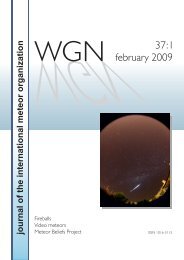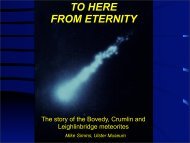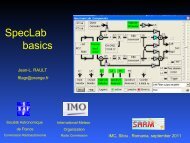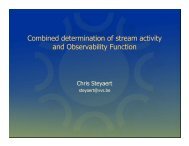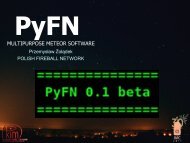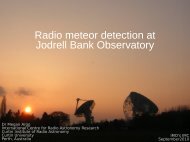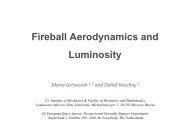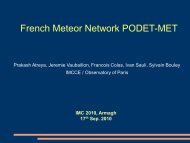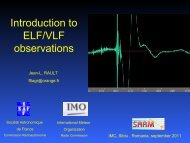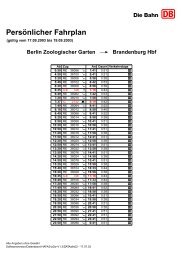Untitled - International Meteor Organization
Untitled - International Meteor Organization
Untitled - International Meteor Organization
You also want an ePaper? Increase the reach of your titles
YUMPU automatically turns print PDFs into web optimized ePapers that Google loves.
WGN, the Journal of the IMO 38:5 (2010) 135<br />
Editorial – Conference and the Orionids<br />
Javor Kac<br />
September and October have again been busy months<br />
for meteor observers.<br />
In September I attended the <strong>International</strong> <strong>Meteor</strong><br />
Conference in Armagh, Northern Ireland. This has<br />
again been an amazing experience for me.<br />
First, exploring a region I have never visited before<br />
is great by itself. While coming to the country was<br />
quite easy – I flew from Ljubljana to Belfast via London<br />
– it was quite hard to organize other details such<br />
as local transport and accommodation before or after<br />
the conference. I ended up hiring a car together with<br />
Mitja Govedič, another participant and fellow observer<br />
from Slovenia. It was a challenge for me to drive on<br />
the left side of the road for the first time, but we survived<br />
about 400 miles on the road. In any case, hiring<br />
a car was a great choice as we could see much of the<br />
country, including marshes, lakes, historic sites, nice<br />
scenic views from the mountain passes and the northern<br />
coast with astonishing cliffs, including the Giant’s<br />
Causeway.<br />
Second, and most importantly, it is always nice to<br />
meet fellow meteor observers and others who work in<br />
meteor astronomy in person. That way, it is much<br />
more practical to exchange views and experiences, plan<br />
new projects, etc. One fine example from this year’s<br />
Conference was Sirko Molau who was answering questions<br />
related with video meteor observing and the<br />
recognition software MetRec to many interested participants<br />
one whole evening. He also accepted many<br />
suggestions to improve the software and even changed<br />
the source code live at the site to implement some<br />
ideas.<br />
Finally, I was pleased we were able to explore the<br />
Armagh Observatory and enjoy the hospitality of the<br />
Figure 1 – Tolis Christou demonstrating the 10-inch Grubb<br />
refractor at the Armagh Observatory.<br />
staff. Many fine vintage instruments are hosted by the institution, including a working example of 10 inch Grubb<br />
refractor, installed in 1885 (Figure 1). I was amazed to see how well the Observatory activities are embedded<br />
into the local environment. However, given the long tradition, this should come as no surprise.<br />
And there is still more exciting news: the Proceedings of IMC 2008 in Šachtička, Slovakia were brought to<br />
the Armagh conference and distributed to delegates. The papers of the Proceedings are listed on page 144. If<br />
you were not present at the Conference in Slovakia but would like to have the Proceedings, see the inside back<br />
cover or the IMO website for details.<br />
Another personal recollection of the Conference is presented in an article by Vaibhav Savant from India (see<br />
page 142).<br />
October brought another enhanced maximum of the Orionids. Their activity was mostly obscured by the<br />
bright moonlight. Despite the adverse conditions and variable weather, I was able to observe for a couple of<br />
hours in the morning of October 21. With 50 Orionids and 69 meteors in total, I was not disappointed. I also<br />
covered some more nights, observing away from the maximum (and the moonlight). The preliminary activity<br />
graph at the IMO live pages shows the Orionids peaked at ZHR about 40 this year.<br />
IMO bibcode WGN-385-editorial NASA-ADS bibcode 2010JIMO...38..135K



